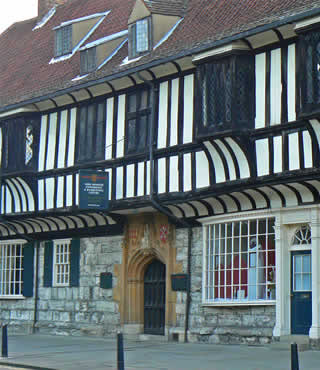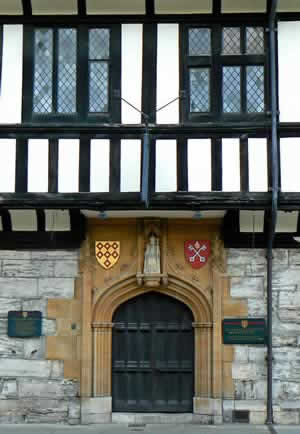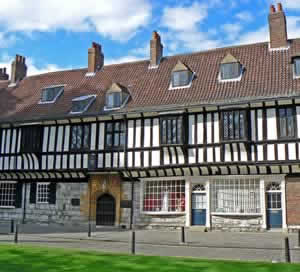St William's College |
|
 |
|||
A fine Tudor building next to York Minster that is used for medieval dinners and conferences |
||||
Listen to this article |
||||
|
||||
 |
||||
On the east side of York Minster, just across the road, stands a distinctive black-and-white timber-framed building called St. William's College. It is one of the architectural highlights of the city, and is decorated with dozens of interesting features, including oak carvings, coats of arms, and a sundial. |
||||
 The front of St William's College |
||||
It dates from the 1400s, when it was built as a residence for the cathedral's priests. These men also helped with the education of the local community, especially the poorer members of society. |
||||
The building is named after William FitzHerbert, a Catholic priest born in the late 11th century. He eventually ascended to the position of Archbishop of York, although his time in the role was full of difficulties. |
||||
He was first elected in 1141, despite not being a favourite for the role. At the time, rumours were flying about many of the candidates, who were suspected of bribery, or worse. Competition was fierce, and after two abandoned elections, William was finally selected for the position. However, that wasn't the end of the scandal. It was well known that the new archbishop was related to Stephen, the King of England, and several religious leaders accused him of using this influence to acquire the job. He denied these charges, but the dissenters weren't convinced. |
||||
 |
||||
The arguments raged back and forth for months. William even travelled to Rome, in the hope of convincing the Pope to confirm his status. Unfortunately for him, he was eventually stripped of the title, and sent home. But this still wasn't the end of the story - King Stephen was outraged at the treatment of his family member, and came to William's aid. He campaigned for the reversal of the decision, and prevented the new archbishop from settling in York. |
||||
By this time, the saga had been going on for many years, and it took until the year 1153 for William FitzHerbert to be restored as Archbishop. Sadly, he still couldn't shake off his bad luck. When hundreds of his supporters turned out to see his return to York, the immense weight caused the Ouse Bridge to collapse completely! |
||||
Incredibly, no-one was hurt. But William was never destined to live in peace, and just one month after his triumphant return, he passed away. Many believe that he was murdered, via a poisoned chalice at Mass - but this was never proven, and so William's death, along with most of his life, was spent in the middle of a storm of controversy. |
||||
Despite all this, his reign as archbishop had been popular with the Yorkshire townsfolk, and so his grave in York Minster received many visitors. For many years, reports emerged of great miracles occurring beside his tomb, and eventually, in 1226, he was canonised, becoming Saint William FitzHerbert for ever more. |
||||
The building which bears his name also remains popular, and is used for a wide variety of events, such as conferences, meetings, and medieval dinners. There is also a small cafe here, which is frequented by visitors to the Minster. But of course, even if you're not thirsty, St. William's College is still worth visiting - just for itself. |
||||
|
||||
St William's College is only open to the public for special events. Tel: 01904 658654 |
||||
|
Pocket Britain is optimised for use on a smartphone or tablet with internet access. All content is subject to copyright. All reasonable methods have been used to ensure information supplied is accurate at the time of publication. However, it is advisable to check information before relying on it. Privacy Policy |